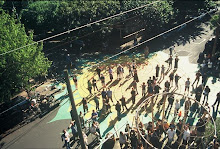
I started my second batch of wine a few weeks ago. And just racked it for the 2nd time. In Aug 07 I started the first batch, 1 gallon of blackberry wine... 7lbs of blackberries collected from the alleys of North Portland. A rewarding experience, which only produced 4 bottles of wine. In July I made my first two batches of beer, a stout and an amber ale... both fantastic according to the consumers.
This year, I picked 15 lbs of black/purple plums from a local tree and started 5 gallons of wine with my friend Melanie's help. In the first 10 days, it reached 8% alcohol, though it should ferment for months until it finishes. About 3-4 wks after the fruit had been removed, it had about 3/4 gal of sediment on the bottom and I just racked it 2 days ago to get it off the sediment. The wine is a brilliant pink. And it will come to about $2.50-$3.50 a bottle, depending on the actual yield. Pretty amazing for wild, homemade goodness.
The sediment makes a wonderful, rather nutritious drink I imagine.... wine, spent yeast (kinda like nutritional yeast), some fine fruit pulp. Definitely still sweet, might be even more perfect as a wine spritzer of sorts by adding sparkling water.
While learning to make wine, I continue to think about ways to improve the process, and by improve I mean thinking back to techniques. I like to do things naturally...and I don't mean like "naturally grown" or "all natural" you see on labels in the grocery store. Oftentimes, that seems like bullshit or greenwashing.
People used to do things much differently... 50 yrs ago, 100yrs ago... they didn't rely on the machine or a big cement box to pump things out for them that they needed. So in making fermented foods/drinks myself, i research and dabble in finding replacements for things that pass through the industrial cement box before reaching me. After all, i'm making it for myself with pure intent...why would i choose anything less.
Making beer and/or wine the modern way requires many industrial ingredients, no matter whether they are naturally derived or not. For example, commercial yeast strains, yeast nutrients, pectic enzyme, tannins, acid blends, malt extract, chemical sanitizers, sulfite tablets to kill bacteria & yeast and sterilize the wine must.
Post-carbon/oil solutions:
- sanitizer -> boiling water - from everything i've read, if you're careful, you'll rarely have a batch go bad.
- modern commercial yeast -> what about that wild sourdough starter you make bread with; they say it won't result in consistent wine/beer, but hey, it originally came from the same strains... i'm interested in trying a sourdough starter and experimenting to determine the right amount that works
- acid Blend -> citrus fruits (lemons) do the trick and minimally affect the flavor, if at all
- tannins -> a couple oak leaves (haven't tried this yet) or strong black tea will do
- malt extract -> take the next step to all-grain brewing
The other ingredients i'm still researching.
I'm also not a big fan of fermenting in plastic vessels, so the first gallon of wine I did, I started in a 2 gal fish bowl I found at goodwill. It was cheap and clean. I need to find a 6-gal equivalent glass container for starting 5gal of wine. Carboys don't work for the first week or so of fermentation, because you need a large open top so you can remove the fruit later.
 I've been making hot-spiced wine for a few years now during the colder months, mostly because it's so darn easy.
I've been making hot-spiced wine for a few years now during the colder months, mostly because it's so darn easy.






